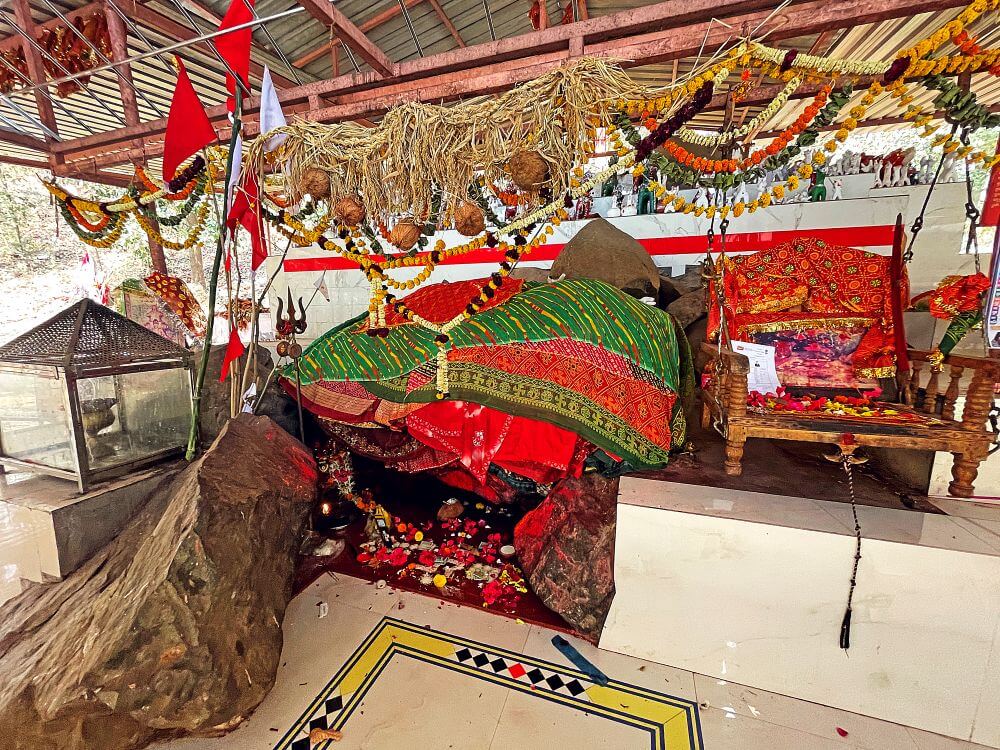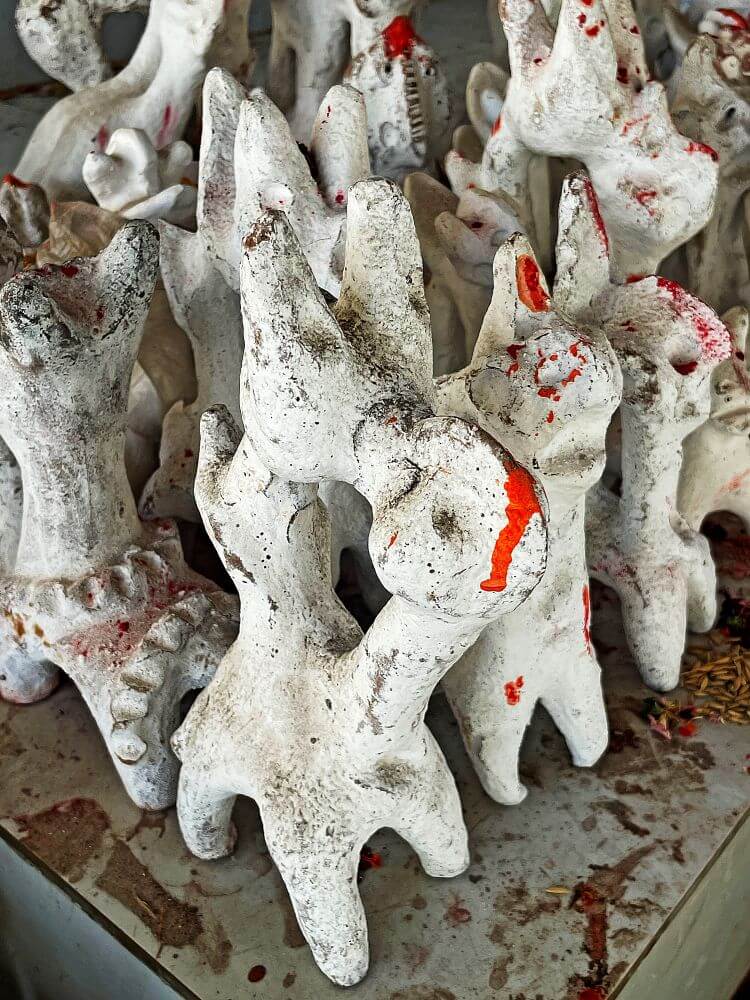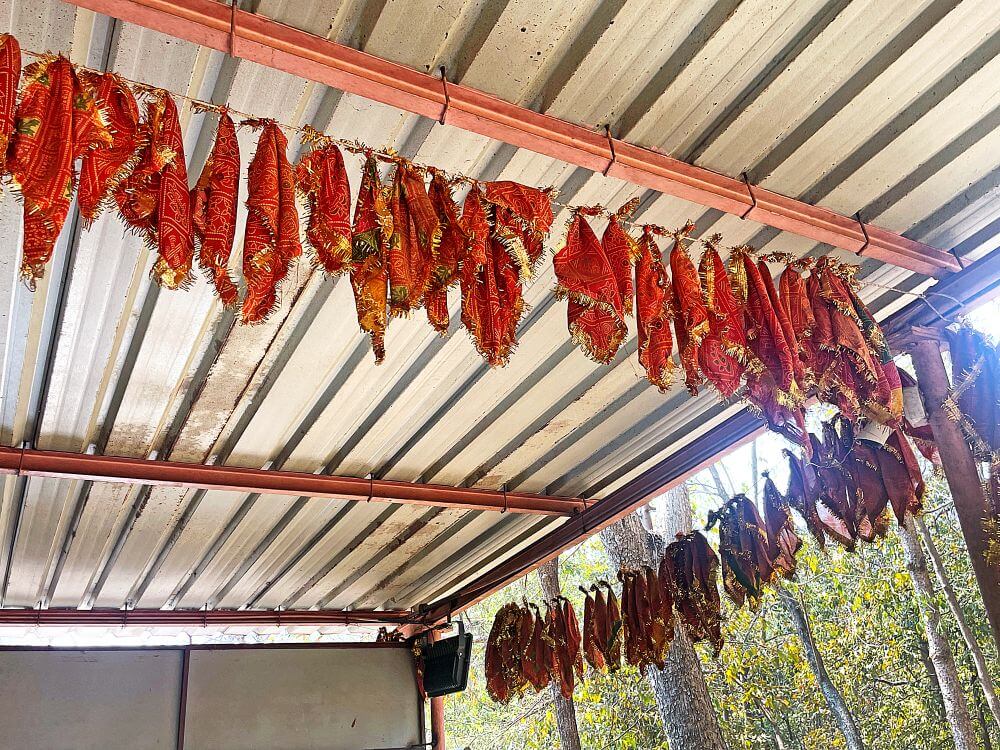 Kansari Mata is revered as the Goddess of Grain and is the kuldevi (clan goddess) of the Bhil community living in the Satpura mountain ranges. She is also known by names like Devmogra, Yaha Mogi, and Panduri Devi. Her original temple is located at Devmogra in Sagbara, Narmada district, but she is worshipped at many places across Gujarat and Maharashtra. One of the important sites dedicated to her is in the forested region of Kavla village. For the tribal communities here, Kansari Mata is considered a form of Goddess Annapurna, the provider of food. Devotees from the surrounding areas have deep faith in her.
Kansari Mata is revered as the Goddess of Grain and is the kuldevi (clan goddess) of the Bhil community living in the Satpura mountain ranges. She is also known by names like Devmogra, Yaha Mogi, and Panduri Devi. Her original temple is located at Devmogra in Sagbara, Narmada district, but she is worshipped at many places across Gujarat and Maharashtra. One of the important sites dedicated to her is in the forested region of Kavla village. For the tribal communities here, Kansari Mata is considered a form of Goddess Annapurna, the provider of food. Devotees from the surrounding areas have deep faith in her.
In his 1956 book The Bhils – A Study, T.B. Naik, a lecturer in Cultural Anthropology at the School of Oriental and African Studies, University of London, recorded many legends about Bhil deities. According to him, Raja Pantha is a revered Bhil deity, and Kansari Mata (Devmogra) is his consort. Many tribal folk songs, called Devageet, in the Bhiori language of Bhils, sing of her greatness. One such song highlights her connection with agriculture and livestock : ‘ડોગુ કોસલે અહીંયે ગઢ બાંધેલો મા દેવે । તિયા ગઢુને બેના ખાંભ રોપેલો મા દેવે । તિયા ખાંભા પે તો ગોરો દાવો બાંધેલો મા દેવે । તિયા દાવાએ ગોરી ગાય બાંધેલી મા દેવે । તિયા ઢાળયા કી ઉબળી ખેતી કહી દીધી મા દેવે ।’. It means, ‘On the cliff of the mountain lies the goddess’s home, She planted a sacred post, tied a white cow to it, The cow gave birth to a white calf, And with that calf, we plowed our fields.’
According to him, Raja Pantha is a revered Bhil deity, and Kansari Mata (Devmogra) is his consort. Many tribal folk songs, called Devageet, in the Bhiori language of Bhils, sing of her greatness. One such song highlights her connection with agriculture and livestock : ‘ડોગુ કોસલે અહીંયે ગઢ બાંધેલો મા દેવે । તિયા ગઢુને બેના ખાંભ રોપેલો મા દેવે । તિયા ખાંભા પે તો ગોરો દાવો બાંધેલો મા દેવે । તિયા દાવાએ ગોરી ગાય બાંધેલી મા દેવે । તિયા ઢાળયા કી ઉબળી ખેતી કહી દીધી મા દેવે ।’. It means, ‘On the cliff of the mountain lies the goddess’s home, She planted a sacred post, tied a white cow to it, The cow gave birth to a white calf, And with that calf, we plowed our fields.’
Another Devageet describes her dwelling : ‘યે ચારી ઓવરી ફિરેલી દેવે અહીં મોગીરા । યે કેલ્લો રાજ ગમેલો દેવે અહીં મોગીરા । યે હેલ્લો દાબ ગમેલો દેવે અહીં મોગીરા । યે હેલ્લો દાબૂં રેનારે દેવે અહીં મોગીરા । યે હેલ્લો વારો ચાલે હે દેવે અહીં મોગીરા ।’ It means – ‘You wandered all four directions, O Yaha Mogi, You settled in Dabh, you liked the cool valley, You stayed where the gentle winds blow.’ Similarly, Kansari Mata’s temple in Kavla is situated on the slopes of a hill, amidst nature.
The Songadh Taluka, part of Tapi district formed in 2007 after the division of Surat district, is home to this temple. Kavla village lies in the forested Satpura hills, near the Gujarat–Maharashtra border. In 1719, Pilajirao Gaekwad, founder of the Baroda State, captured the Sonaghad Fort from the local Bhils. With help from local tribespeople, he strengthened this fort in 1721, marking it as his first main base. He also constructed a royal palace within its enclosure,  leading to the town being named Sonagad.
leading to the town being named Sonagad.
The temple located in this forest has a large courtyard in front of it, where a saffron flag flutters atop a pillar. To the right of the temple lies an ancient well. The temple dedicated to Kansari Mata reflects the simplicity of tribal life. It is built on a hillside at an elevated position with stone foundations and has a thatched roof. There are some steps leading up to the temple. At its lower level is an assembly hall and above it is the sanctum sanctorum.
In this upper hall are marble-tiled platforms with some stone slabs featuring a small cave-like space housing a stone idol of Kansari Mata adorned with colorful cloths. To the right side of this site sits an idol of the goddess on a wide wooden chair, while on the left side burns an eternal lamp. Beyond that, at the back in an open shrine, six stone idols are placed. Offerings of coconuts and sheaf of grains are tied to the beams above the goddess’s shrine.
Nearby and behind this site are platforms adorned with several earthen horse figurines and statues resembling horses. These horses and similar distinctive figures are brought here as offerings when fulfilling vows made to the goddess. Her devotees believe that this goddess fulfills vows and prayers. Being the Goddess of Grain, there is a tradition of offering the first harvest from the field to her. Only after this ritual is the grain used at home or sold in the market.
Devotees visiting the temple carry a bamboo basket (hijari) containing coconut, rice grains, and other offerings. A grand festival is held during Navratri, when thousands of devotees arrive with traditional instruments, singing Devageets in her praise. After offering grains to the goddess, many devotees cook and share meals at the site.
